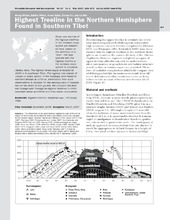| dc.contributor.author | Miehe, Georg | eng |
| dc.contributor.author | Miehe, Sabine | eng |
| dc.contributor.author | Vogel, Jonas | eng |
| dc.contributor.author | Co, Sonam | eng |
| dc.contributor.author | Duo, La | eng |
| dc.date.accessioned | 2007-12-06T12:30:50Z | |
| dc.date.available | 2007-12-06T12:30:50Z | |
| dc.date.issued | 2007 | eng |
| dc.Published | Mountain Research and Development 2007 27 (2): 169-173 | en |
| dc.identifier.issn | 0276-4741 | en_US |
| dc.identifier.uri | https://hdl.handle.net/1956/2482 | |
| dc.description | This article was first published in "Mountain Research and Development" (MRD), vol 27 no 2, pp 169-173. The rights of reproduction remain with the co-copyright holders: The International Mountain Society (IMS) and the United Nations University (UNU), c/o MRD Editorial Office, Bern, Switzerland (www.mrd-journal.org). | |
| dc.description.abstract | Three new records of the highest treelines in the northern hemisphere are presented here, based on the definition of a “tree.” The tree species with the highest treeline in the northern hemisphere is Juniperus tibetica Kom. The highest forest stand is located at 4900 m in southeast Tibet. The highest tree stands of Juniperus indica Bertol. In the Himalaya were found in northern Bhutan at 4750 m. Information from such observations is decisive for the development of hypotheses on the limits of tree growth. We compare the present findings with findings on highest treelines in other mountain areas worldwide and draw some conclusions. | en_US |
| dc.language.iso | eng | eng |
| dc.publisher | International Mountain Society | en_US |
| dc.subject | Highest treeline | eng |
| dc.subject | Juniperus spp | eng |
| dc.subject | Himalaya | eng |
| dc.subject | Tibet | eng |
| dc.title | Highest treeline in the Northern Hemisphere found in Southern Tibet | en_US |
| dc.type | Peer reviewed | |
| dc.type | Journal article | |
| dc.identifier.doi | https://doi.org/10.1659/mrd.0792 | |
| dc.subject.nsi | VDP::Matematikk og Naturvitenskap: 400::Zoologiske og botaniske fag: 480 | nob |
